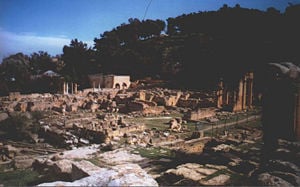Cyrene, Libya
| Archaeological Site of Cyrene* | |
|---|---|
| UNESCO World Heritage Site | |

| |
| State Party | 22px Libyan Arab Jamahiriya |
| Type | Cultural |
| Criteria | ii, iii, vi |
| Reference | 190 |
| Region** | Arab States |
| Inscription history | |
| Inscription | 1982 (6th Session) |
| * Name as inscribed on World Heritage List. ** Region as classified by UNESCO. | |
Cyrene (Greek Κυρήνη, Kurene) was an ancient Greek colony in present-day Libya, the oldest and most important of the five Greek cities in the region. It gave eastern Libya the classical name 'Cyrenaica' that it has retained to modern times. It lies in a lush valley in the Jebel Akhdar uplands. Named after a spring, Kyre, which the Greeks consecrated to Apollo, the city was the seat of a famous school of philosophy in the 3rd century B.C.E., founded by Aristippus, a disciple of Socrates.
History
Greek period
Cyrene was founded as a colony of the Greeks of Thera (modern Santorini), traditionally led by Battus I, in 630 B.C.E., ten miles from its port, Apollonia (Marsa Sousa). Details concerning the founding of the city are contained in Book IV of the Histories of Herodotus. It promptly became the chief town of ancient Libya and established commercial relations with all the Greek cities, reaching the height of its prosperity under its own kings in the 5th century B.C.E.. Soon after 460 B.C.E. it became a republic; after the death of Alexander the Great (323 B.C.E.) it was passed to the Ptolemaic dynasty.
Ophelas, the general who occupied the city in Ptolemy I's name, ruled the city almost independently until his death, when Ptolemy's son-in-law Magas received governorship of the territory. In 276 B.C.E. Magas crowned himself king and declared de facto independence, marrying the daughter of the Seleucid king and forming with him an alliance in order to invade Egypt. The invasion was unsuccessful, and in 250 B.C.E., after Magas' death, the city was reabsorbed into Ptolemaic Egypt. Cyrenaica became part of the Ptolemaic empire controlled from Alexandria, and became Roman territory in 96 B.C.E. when Ptolemy Apion bequeathed Cirenaica to Rome. In 74 B.C.E. the territory was formally transformed into a Roman province.
Roman period
The inhabitants of Cyrene at the time of Sulla (c. 85 B.C.E.) were divided into four classes: citizens, farmers, resident aliens, and Jews, who formed a restless minority. The ruler of the town, Apion bequeathed it to the Romans, but it kept its self-government. In 74 B.C.E. Cyrene was created a Roman province; but, whereas under the Ptolemies the Jewish inhabitants had enjoyed equal rights, they now found themselves increasingly oppressed by the now autonomous and much larger Greek population. Tensions came to a head in the insurrection of the Jews of Cyrene under Vespasian (73) and especially Trajan (117). This revolt was quelled by Marcius Turbo, but not before huge numbers of people had been killed. [1]. According to Eusebius the outbreak of violence left Libya depopulated to such an extent that a few years later new colonies had to be established there by emperor Hadrian just to maintain the viability of continued settlement.
Plutarch in his work De mulierum virtutes ("On the Virtues of Women") describes how the tyrant of Cyrene, Nicocrates, was deposed by his wife Aretaphila of Cyrene around the year 50 B.C.E. [2]
Decadence
Cyrene's chief local export through much of its early history, the medicinal herb silphium, was pictured on most Cyrenian coins, until it was harvested to extinction, and commercial competition from Carthage and Alexandria reduced the city's trade.
Cyrene, with its port of Apollonia (Marsa Susa), remained an important urban center until the earthquake of 262. After the disaster, the emperor Claudius Gothicus restored Cyrene, naming it Claudiopolis, but the restorations were poor and precarious, and soon decadence hit Cyrene irremediably. Natural catastrophes and a profound economic decline dictated its death, and in 365 another particularly devastating earthquake destroyed its already meager hopes of recovery. Ammianus Marcellinus described it in the 4th century as "a deserted city", and Synesius, a native of Cyrene, described it in the following century as "a vast ruin at the mercy of the nomads".
The final chapter occurred in 643, with the Arab conquest. Little was left of the opulent Roman cities of Northern Africa; the ruins of Cyrene are located near the modern village of Shahhat, in Libyan territory.
Philosophy
Cyrene was the birthplace of Eratosthenes and there are a number of philosophers associated with the city including Aristippus, the founder of the School of Cyrene, and his successor daughter Arete, Callimachus, Carneades, and Synesius, bishop of Ptolemais in the 4th century CE.
Archaeology
Cyrene is now an archaeological site near the village of Shahhat. One of its more significant features is the Temple of Apollo which was originally constructed as early as the 7th century B.C.E. Other ancient structures include a Temple to Demeter and a partially unexcavated Temple to Zeus (the latter was intentionally damaged under orders of Muammar al-Gaddafi in the summer of 1978). There is a large necropolis approximately 6 miles (10 km) between Cyrene and its ancient port of Apollonia.
Cyrene in the Bible
Cyrene is mentioned in 2 Maccabees: The book of 2 Maccabees itself is said by its author to be an abridgment of a five-volume work by a Hellenized Jew by the name of Jason of Cyrene who lived around 100 B.C.E. (Both the Catholic and the Eastern churches consider 2 Maccabees to be canonical; Protestants do not.)
Cyrene is also mentioned in the New Testament: One Simon of Cyrene was the person compelled by the Romans to carry the cross of Jesus as he was taken to his crucifixion, according to the Gospels of Mark (15:21-22), Matthew (27:32) and Luke (23:26).
See also Acts 2:10, 6:9; 11:20; 13:1, where Jews from Cyrene heard the disciples speaking in their own language in Jerusalem on the day called Pentecost.
Ruins
The modern town of Shahhat in al-Jabal al-Akhdar district partially occupies the site of ancient Cyrene.
The site of ancient Cyrene is partly occupied by the modern village of Shahhat in al-Jabal al-Akhdar, eight miles southwest of Marsa Susah. Three main areas of the city have been excavated: the fountain and sanctuary of Apollo, where the Venus of Cyrene and a colossal statue of Apollo were found; the upper city, site of a forum and basilica modelled on the Kaisareion of Alexandria, and a large 2nd-century house with fine mosaics; and the centre of the Roman town, in which stands a huge Doric column marking the site of the temple of Zeus, a gigantic Doric building of the late 6th century B.C.E.
http://www.globalheritagefund.org/where/cyrene.html
New discoveries
In 2005, Italian archaeologists from the University of Urbino discovered 76 intact Roman statues at Cyrene from the 2nd century C.E. The statues remained undiscovered for so long because “during the earthquake of 375 C.E., a supporting wall of the temple fell on its side, burying all the statues. They remained hidden under stone, rubble and earth for 1,600 years. The other walls sheltered the statues, so we were able to recover all the pieces, even works that had been broken." [3]
Notes
- ↑ Cassius Dio, lxviii. 32
- ↑ University of Chicago. De Mulierum Virtutibus by Plutarch as published in Vol. III of the Loeb Classical Library edition, 1931. Retrieved June 10, 2008.
- ↑ Mario Luni. 2005. As interviewed by The Art Newspaper. London.
ReferencesISBN links support NWE through referral fees
- Applebaum, Shimon. 1979. Jews and Greeks in ancient Cyrene. Studies in Judaism in late antiquity, v. 28. Leiden: E.J. Brill. ISBN 9789004059702
- Calame, Claude. 2003. Myth and history in ancient Greece: the symbolic creation of a colony. Princeton: Princeton University Press. ISBN 9780691114583
- Cassius Dio Cocceianus, Earnest Cary, and Herbert Baldwin Foster. 1914. Dio's Roman history, with an English translation. London: W. Heinemann.
- Global Heritage Fund. Cyrene, Libya - An ancient Greek site Retrieved June 10, 2008.
- Gottheil, Richard and Samuel Krauss. Cyrene Jewish Encyclopedia. Retrieved June 10, 2008.
- Lendering, Jona. Cyrene and the Cyrenaica Livius. Retrieved June 10, 2008.
External links
Credits
New World Encyclopedia writers and editors rewrote and completed the Wikipedia article in accordance with New World Encyclopedia standards. This article abides by terms of the Creative Commons CC-by-sa 3.0 License (CC-by-sa), which may be used and disseminated with proper attribution. Credit is due under the terms of this license that can reference both the New World Encyclopedia contributors and the selfless volunteer contributors of the Wikimedia Foundation. To cite this article click here for a list of acceptable citing formats.The history of earlier contributions by wikipedians is accessible to researchers here:
The history of this article since it was imported to New World Encyclopedia:
Note: Some restrictions may apply to use of individual images which are separately licensed.








